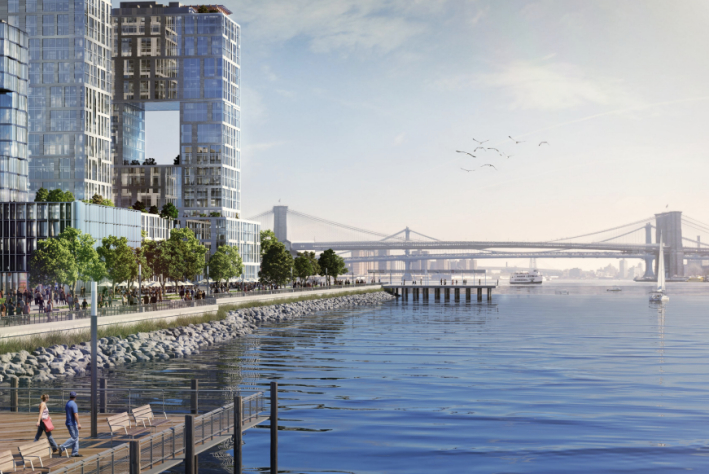Yesterday afternoon, Mayor Bloomberg unveiled a resiliency plan to better prepare New York for flooding due to climate change and severe storms. The report's team, put together in the wake of Hurricane Sandy and led by Economic Development Corporation President Seth Pinsky, used the administration's PlaNYC 2030 sustainability plan as the foundation for a sweeping set of resiliency-specific recommendations, covering everything from temporary bikeways to new landfill development on the East River.

The heart of the mayor's plan would build levees and barriers at targeted locations, including the Rockaways, Staten Island, Coney Island, and Newtown Creek, to protect vulnerable areas from flooding. These barriers could offer opportunities for permanent esplanades and greenways for these neighborhoods.
While the levees only tangentially involve transportation, most of the plan's transportation-specific initiatives didn't receive marquee treatment in the mayor's speech and are instead buried in the report. If implemented, however, they could be major components of both the city's storm response and its permanent infrastructure.
In the aftermath of Hurricane Sandy, many New Yorkers took to bicycling and walking as the only reliable means of transit, but improved pedestrian and bike access was not part of the city's response plan. The mayor's new report recommends that DOT and NYPD be ready to deploy "temporary pedestrian and bicycle capacity" in the event of an emergency, including dedicated lanes leading to ferry terminals and the East River bridges, as well as on the bridges themselves, by the end of 2014.
After Hurricane Sandy, the city and state implemented temporary bus service while subways below 34th Street were without power. The plan calls on DOT to coordinate with the MTA and other agencies on the implementation of similar "bus bridges" or ferry links in case of emergency, as well as to investigate greater access for city residents to Metro-North and Long Island Rail Road, with the possibility of "cross-honoring" tickets in case of service disruption.
Like the bus connections, HOV-3 restrictions for vehicles entering the Manhattan central business district came after a day of crippling gridlock when many drivers drove to work alone. The report calls for a plan by the end of 2013 so the DOT, NYPD, and the Office of Emergency Management know when to implement HOV-3 restrictions in case of emergency and are able to quickly set up HOV-3 enforcement. (A bill from Council Members Deborah Rose and James Vacca is being introduced to the Public Safety committee today to require OEM to develop a broader emergency traffic management plan.)
In addition to temporary interventions during an emergency, the plan also has recommendations that would affect how New Yorkers travel on non-emergency days, most notably by devoting more road and highway space to buses.
The plan says the city will continue to expand the number of Select Bus Service routes. In addition to routes already in planning or development for Nostrand Avenue, 125th Street, Webster Avenue, Astoria Boulevard, and Woodhaven Boulevard, the report says that "over the next five years NYC DOT will work with the MTA to implement four additional SBS routes," though it does not specify which routes are on track for implementation.
The report also highlights the value of buses not just on surface streets, but also on expressways, calling for "15 miles of bus priority corridors" on highways, similar to the bus lanes already on the Long Island, Gowanus, and Staten Island Expressways. It also mentions the possibility of running buses on highway shoulders and aims for the first of the new or expanded bus facilities to be complete within five years. (Separately, a bill requiring NYSDOT to study an extension of the Staten Island Expressway's bus/HOV lanes from Victory Boulevard to the West Shore Expressway passed the Senate yesterday and now sits before the Assembly's transportation committee.)
The city's report joins the recommendations of the state's NYS 2100 commission, which also called for investing in bus rapid transit.
Ferries also feature prominently in the city's report. EDC is updating the Comprehensive Citywide Ferry Study, first published in 2011, with an eye toward the East River, Staten Island, and the Rockaways. Coney Island businesses are already advocating for ferry service, the city has committed to subsidizing ferries to Red Hook this summer as part of the neighborhood's post-Sandy recovery, and ferry service to the Rockaways was recently extended. EDC will also develop two "ferry landing barges" that can be temporarily deployed to areas in need of ferry service after a disaster.
Perhaps the boldest vision in the mayor's plan is for Seaport City, which would add new developable land south of the Brooklyn Bridge raised above flood level -- an east side version of Battery Park City. Seaport City may provide an opportunity to improve the East River Greenway and convert the FDR Drive to a surface road instead of an elevated highway. The Blueway Plan, a vision for the East River waterfront from the Brooklyn Bridge north to 38th Street, was released in February by Manhattan Borough President Scott Stringer and Assembly Member Brian Kavanagh and also included anti-flooding measures.
In its write-up of the report, Tri-State Transportation Campaign notes that while the plan lays out a lot of unfunded recommendations, it does pay more attention to financing its ideas than the NYS 2100 commission did earlier this year. In fact, there's an entire column in the report dedicated to the "MoveNY" proposal from Sam Schwartz to raise funds by more equitably tolling region's bridges and tunnels. "Given the fact that there is a nexus between auto usage and climate change, and that many of the areas that would benefit from toll reductions are also areas that are recovering from Sandy," the report says, "the City believes it would be prudent for New Yorkers and their future leaders to evaluate the MoveNY proposal."





